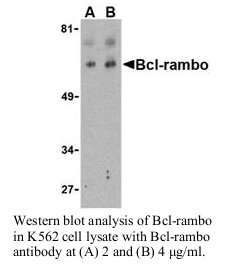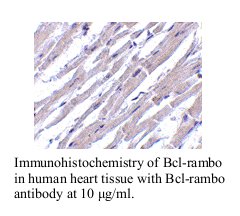Anti-Human Bcl-Rambo (Intermediate Domain)
Data
- -
- -
Antibody DetailsProduct DetailsReactive Species Human Host Species Rabbit Immunogen PN:B475 Product Concentration 0.5 mg/ml Formulation This polyclonal antibody is formulated in phosphate buffered saline (PBS) pH 7.4 containing 0.02% sodium azide as a preservative. Storage and Handling This polyclonal antibody is stable for at least one week when stored at 2-8°C. For long term storage, aliquot in working volumes without diluting and store at – 20°C in a manual defrost freezer. Avoid Repeated Freeze Thaw Cycles. Country of Origin USA Shipping Next Day Ambient RRIDAB_2828207 Each investigator should determine their own optimal working dilution for specific applications. See directions on lot specific datasheets, as information may periodically change. DescriptionDescriptionSpecificity Rabbit Anti-Human Bcl-rambo recognizes an epitope in the intermediate domain of human, mouse and rat Bcl-rambo. This polyclonal antibody was purified using affinity chromatography. Background Apoptosis plays a major role in normal organism development, tissue homeostasis, and removal of damaged cells. Disruption of this process has been implicated in a variety of diseases such as cancer.1 Members of the Bcl-2 family are known to be critical regulators of this process. These proteins are characterized by the presence of several conserved motifs termed Bcl-2 homology (BH) domains.2,3 A novel, widely expressed member termed Bcl-rambo was recently identified. This protein is localized to mitochondria in mammalian cells and its overexpression induces apoptosis which could be blocked by co-expression of inhibitor of apoptosis proteins (IAPs) such as XIAP, cIAP1, and cIAP2.4 Bcl-rambo shows overall homology to the anti-apoptotic members containing BH motifs, but unlike Bcl-2, the C-terminal membrane anchor of Bcl-rambo is preceded by a unique 250 amino acid insertion. This region by itself can induce apoptosis more efficiently than the Bcl-2 homology regions, suggesting that Bcl-rambo may be important other pro-apoptotic pathways.4 PubMed References & Citations1. Lockshin, RA. et al. (2000) Cell Death Differ. 7:2-7. 2. Cory, S. et al. (2003) Oncogene 22:8590-607. 3. Heiser, D. et al. (2004) Exp. Geron. 39:1125-35. 4. Kataoka, T. et al. (2001) J. Biol. Chem. 276:19548-54. Technical ProtocolsCertificate of Analysis |
Related Products
- -
- -
Prod No. | Description |
|---|---|
B449 | |
B475 |




